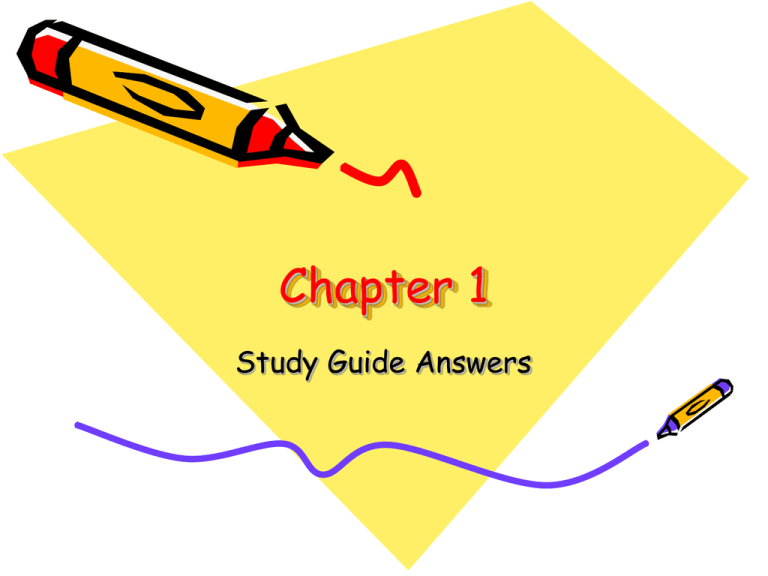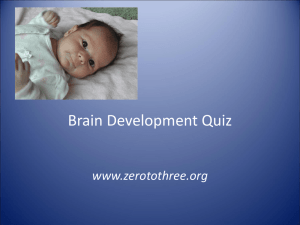Chapter 1: Study Guide PowerPoint Presentation
advertisement

Chapter 1 Study Guide Answers Question 1… • What three things influence your relationship with young children?? – Your interest in children. – Your knowledge of their changing stages and needs. – Your skill in applying that knowledge Question 2… • Why study children? – Your understanding of children will grow – You will come to know yourself better – You will develop skills that will be valuable throughout your lifetime. Question 3… • How can learning about children help you get along with them better? – You will more fully appreciate all characteristics of human development. – You will begin to see why children act, feel, and think as they do. – You will be able to apply your learning to everyday life. – You will learn practical techniques of caring for children. – You will discover that children are fun. Question 4… • What is one of the most important concepts that have emerged from the study of children? – Childhood has been identified as being a distinct period of life and many people have made a special study of this period. – To explain further, We are learning about how children develop, what their special needs are and how these needs can best be met. Many important concepts have emerged from this kind of study; perhaps the most important concept is that childhood has a significant influence on later life. Question 5… • How did people in Colonial Days think children differed from adults? – During the colonial period in America, people still believed that children differed from adults only in size, experience, and abilities. Children were dressed, fed, and doctored just as adults were. Question 6… • Give three examples of the differences between childhood in the past and childhood today. – EXAMPLE ONE (Work): – In the past, children were expected to work hard at an early age. – Today, most children in our society are not thrown into the world of adult work. The “job” of young children is simply to grown, learn, and play. Question 6… • Give three examples of the differences between childhood in the past and childhood today. – EXAMPLE TWO (Nutrition): – Health & Nutrition: In the past, parents could not expect to raise every child to adulthood due to various diseases. Today because of medical care and vaccinations most all children live to adulthood. – In the past, babies either thrived on breast milk or didn’t. Today, we have many types of formulas that help babies grown and develop. Special formulas are available for infants with special dietary needs. Question 6… • Give three examples of the differences between childhood in the past and childhood today. – EXAMPLE THREE (Dress): – Until the seventeenth century, children were dressed as small adults. Preschool boys and girls were dressed alike until the early part of the twentieth century. – Today, young children now usually wear clothing that is suitable in both style and color for either boys or girls. Modern children wear practical, washable, lightweight garments designed to provide freedom of movement and maximum confort. Question 7… • Why can childhood be called a recent discovery, even through there have always been children? – Because attitudes toward children have changed. Our society attached great importance to understanding and guiding children. – Over the past several generations, interest in studying children and their behavior has grown remarkable. For the first time, researchers and scholars have been able to study child growth and development scientifically. Question 8… • Where can you find information about growth and development of children? – Books, articles, radio, television programs, internet, classes. Question 9… • Explain in your own words what the following characteristics of development mean… • Development is similar for everyone… – Regardless of the country where a child is born, that baby will grown and develop physically just like any other baby in any other country. Question 9… • Explain in your own words what the following characteristics of development mean… • Development builds on early learning… – A child learn basic skills or simple tasks before progressing to more complex skills or tasks. Question 9… • Explain in your own words what the following characteristics of development mean… • Development proceeds at an individual rate… – Babies grown and development is similar however, each individual baby will grown and develop and learn at their own individual pace or rate. Question 9… • Explain in your own words what the following characteristics of development mean… • The different areas of development are interrelated… – Babies don’t just grow physically one week and the socially the next week. All the areas of development (physical, mental, social, and emotional) are connected and impact each other. Question 9… • Explain in your own words what the following characteristics of development mean… • Development is continuous throughout life… – Development does not stop at a certain age. We all continue to grown and develop well into adulthood. Question 10… • Identify four ways that play benefits the development of children. – – – – Physically. Intellectually. Emotionally. Socially. Question 11… • Name two major influences on development and give an example of each. – Heredity. What a person looks like, their intellectual capability is determined by their heredity or genetic makeup. – Environment. All the people, places, and things that surround an individual have an impact on the growth and development of that individual.







